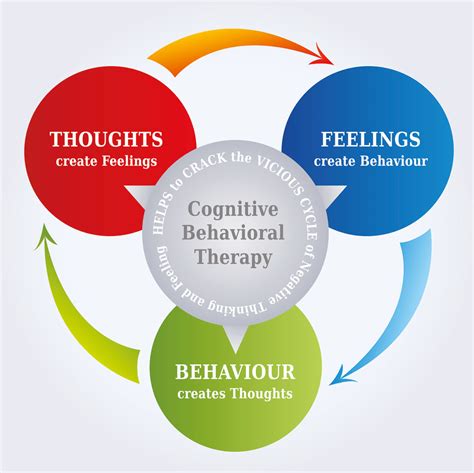Do you ever wonder how our thoughts and beliefs impact our behavior and emotions? Cognitive Behavioral Therapy (CBT) is a popular form of psychotherapy that focuses on the interconnectedness of our thoughts, emotions, and behaviors. In this blog post, we will dive into the world of CBT and explore the key components of this therapeutic approach. From understanding the mind-body connection in CBT to practical techniques for challenging negative thinking patterns, we will explore the core principles of CBT and how it is applied in therapy sessions. Whether you are a mental health professional or simply interested in learning more about CBT, this blog post will provide valuable insights into the effectiveness of CBT interventions and how they can sculpt the mind for positive behavior change. Join us as we unravel the mysteries of CBT and discover the transformative power it holds in promoting psychological well-being.
Table of Contents
What is Cognitive Behavioral Therapy (CBT)?
Cognitive Behavioral Therapy (CBT) is a type of psychotherapy that focuses on the relationship between thoughts, feelings, and behaviors. It is based on the idea that our thoughts and interpretations of events influence how we feel and behave. CBT is a highly effective treatment for a range of mental health conditions, including depression, anxiety, and phobias.
In CBT, the therapist works collaboratively with the client to identify and challenge unhelpful thought patterns and beliefs that contribute to emotional distress and dysfunctional behavior. Through a process of cognitive restructuring, individuals learn to replace negative and distorted thoughts with more realistic and adaptive ones.
Cognitive Behavioral Therapy also incorporates behavioral techniques to help individuals change problem behaviors and develop coping skills. This may involve exposure therapy, relaxation training, or activity scheduling, depending on the specific needs of the client.
Overall, CBT is a goal-oriented and practical approach to therapy, with a focus on developing skills that can be applied to real-life situations. It is grounded in the belief that by changing the way we think and behave, we can improve our emotional well-being and overall quality of life.
Understanding the Mind-Body Connection in CBT
When it comes to cognitive behavioral therapy (CBT), it’s important to understand the close connection between the mind and body. This therapy approach recognizes that our thoughts, emotions, and physical sensations are all interconnected and can influence one another.
By acknowledging the mind-body connection, CBT aims to help individuals understand how their thoughts and beliefs can impact their emotional and physical well-being. It emphasizes the idea that our interpretations of situations can directly affect our emotional and physical responses.
In CBT, therapists work with clients to identify how their thoughts and emotions are affecting their physical sensations and vice versa. By recognizing and understanding these connections, individuals can learn to better manage their emotional and physical reactions to various situations.
Ultimately, by addressing the mind-body connection in CBT, individuals can gain insight into how their thoughts and emotions impact their overall well-being, and develop effective strategies for managing these interconnected aspects of their experiences.
Developing a Cognitive Behavioral Therapy Plan
Developing a Cognitive Behavioral Therapy (CBT) plan involves carefully assessing the underlying issues and determining the most effective strategies to address them. The first step in the process is to conduct a comprehensive assessment of the client’s presenting problems and identify the specific thoughts, emotions, and behaviors that are contributing to their distress. This assessment helps to create a clear picture of the client’s needs and provides a foundation for developing a tailored treatment plan.
Once the assessment is complete, the next step is to collaborate with the client to set specific goals for therapy. These goals should be SMART – Specific, Measurable, Achievable, Relevant, and Time-bound. By establishing clear objectives, both the therapist and the client can track progress and make adjustments to the treatment plan as needed.
After setting goals, the therapist and client work together to identify and challenge negative thinking patterns and develop more adaptive ways of thinking. This may involve using cognitive restructuring techniques to examine the evidence for and against a client’s negative beliefs and to replace them with more rational and positive thoughts.
Finally, the therapist and client collaborate to develop an action plan for achieving the identified goals. The action plan may include specific strategies and techniques for managing distressing emotions, changing unhelpful behaviors, and improving coping skills. By working together to create a clear and structured plan, the client can feel empowered and supported throughout the therapeutic process.
The Role of Thoughts and Beliefs in CBT
Cognitive Behavioral Therapy (CBT) is a psychotherapy approach that aims to help individuals identify and change negative thought patterns and beliefs that contribute to their emotional distress and behavioral issues. One of the key principles of CBT is the recognition of the profound impact that thoughts and beliefs have on an individual’s emotional state and behavior.
CBT posits that our thoughts and beliefs influence our feelings and actions. For example, if someone has a belief that they are not good enough, they may feel anxious or depressed, and they may engage in behaviors that confirm their belief, such as avoiding social situations or procrastinating on tasks.
In CBT, therapists work with clients to identify and challenge these negative thought patterns and beliefs. Through various techniques such as cognitive restructuring and thought records, individuals learn to reframe their thoughts and develop more adaptive beliefs that lead to improved emotional well-being and healthier behaviors.
The incorporation of thoughts and beliefs in CBT highlights the importance of addressing the cognitive component of mental health issues and emphasizes the power of our interpretations and perceptions in shaping our emotional experiences and actions.
Applying CBT Techniques in Therapy Sessions
When it comes to Cognitive Behavioral Therapy (CBT), one of the key aspects is the application of various techniques in therapy sessions. CBT techniques are practical tools that are used to help individuals recognize and change their negative thought patterns, behaviors, and emotions.
One of the techniques commonly used in CBT therapy sessions is behavioral activation, which involves identifying and engaging in positive, rewarding activities to counteract feelings of depression or anxiety. This technique helps individuals break the cycle of avoidance and withdrawal, and instead, encourages them to participate in enjoyable and meaningful activities.
Exposure therapy is another CBT technique used in therapy sessions to help individuals confront and overcome their fears or phobias. This technique involves gradually exposing individuals to the situations or objects that cause them anxiety or distress, and teaching them how to manage their reactions and responses.
Thought challenging is a fundamental CBT technique that is applied in therapy sessions to help individuals identify and challenge their negative and distorted thinking patterns. By examining the evidence for and against their negative thoughts, individuals learn to replace irrational beliefs with more balanced and realistic thoughts.
Challenging Negative and Distorted Thinking Patterns
Cognitive Behavioral Therapy (CBT) is a widely used approach in psychology that focuses on challenging negative and distorted thinking patterns as a means of promoting behavior change and improving mental health. This approach is based on the premise that our thoughts, feelings, and behaviors are interconnected, and that by changing our thoughts, we can change our feelings and behaviors.
In CBT, individuals are taught to identify their negative and distorted thinking patterns, such as catastrophizing, overgeneralization, and black-and-white thinking. Once these patterns have been identified, individuals are then guided through the process of challenging and reframing these thoughts in a more balanced and rational way. This involves examining the evidence for and against the negative thought, as well as considering alternative perspectives and interpretations.
Challenging negative and distorted thinking patterns can be a difficult and uncomfortable process, as individuals are often deeply entrenched in their negative beliefs and assumptions. However, with the guidance and support of a trained therapist, individuals can learn to recognize and reframe their negative thinking patterns, leading to a more balanced and realistic view of themselves and their circumstances.
By challenging negative and distorted thinking patterns, individuals can experience a reduction in emotional distress, an improvement in mood, and a greater sense of control over their thoughts and behaviors. This process is a fundamental aspect of CBT, and is an essential component of therapy for those seeking to overcome issues such as depression, anxiety, and other mental health concerns.
Promoting Behavior Change through CBT
Cognitive Behavioral Therapy (CBT) is a widely-used and effective form of psychotherapy that focuses on the relationship between thoughts, feelings, and behaviors. It aims to help individuals identify and challenge negative thought patterns and develop more adaptive ways of thinking and behaving. One of the key goals of CBT is promoting behavior change by addressing the underlying thought patterns that contribute to maladaptive behaviors.
CBT interventions are designed to target specific behaviors that are causing distress or impairment in a person’s life. By helping individuals identify and understand the thought patterns that drive their behaviors, CBT therapists can work with clients to develop alternative ways of thinking and responding to situations. This process can lead to significant behavior change and improvement in overall functioning.
In promoting behavior change through CBT, therapists often use behavioral experiments to test the validity of a client’s beliefs and thoughts. By engaging in these experiments, clients can see firsthand how their thought patterns influence their behavior and emotions. This process helps to challenge and modify maladaptive behaviors, ultimately leading to positive changes in overall behavior.
Another key aspect of behavior change in CBT is the use of homework assignments and practice exercises. Clients are often asked to engage in activities outside of therapy sessions that are designed to reinforce and apply the skills and strategies they have learned in therapy. By consistently practicing these new behaviors and thought patterns, clients can promote lasting behavior change and maintain progress in the long term.
Addressing Emotions and their Impact on Behavior
Emotions play a significant role in shaping our behaviors and actions. The way we feel affects the way we behave, and this connection is an important aspect of Cognitive Behavioral Therapy (CBT). Addressing emotions and their impact on behavior is a crucial part of the therapeutic process, as it allows individuals to understand how their emotions influence their actions and vice versa.
One of the key principles of CBT is the idea that our emotions are closely linked to our thoughts and behaviors. When we experience negative emotions, such as sadness or anxiety, it can lead to negative behaviors, like avoidance or isolation. By addressing the underlying emotions and helping individuals understand the relationship between their emotions and behaviors, CBT aims to promote positive changes in their thought patterns and actions.
It is essential to recognize that negative emotions can have a significant impact on behavior, often leading to self-destructive or harmful actions. By addressing these emotions in therapy, individuals can learn to manage their feelings in a healthier way, leading to more constructive behaviors and improved overall well-being. Through techniques such as emotion regulation and mindfulness, CBT helps individuals identify and address their emotions in a way that promotes positive behavior change.
By addressing emotions and their impact on behavior, CBT empowers individuals to take control of their emotional responses and make healthier choices in how they respond to their feelings. This can lead to a more positive and fulfilling life, as individuals learn to navigate their emotions in a way that promotes well-being and positive behavior.
Using Mindfulness and Meditation in CBT
Mindfulness and meditation are powerful tools that can be integrated into Cognitive Behavioral Therapy (CBT) to enhance its effectiveness. By incorporating these practices into therapy sessions, individuals can cultivate a greater awareness of their thoughts, emotions, and bodily sensations, ultimately leading to a more balanced and grounded state of mind.
One of the key principles of CBT is the recognition of the interconnectedness of the mind and body. Mindfulness and meditation serve as vehicles for clients to develop a deeper understanding of this mind-body connection, allowing them to observe their thoughts and feelings without judgment and develop a more compassionate relationship with themselves.
These practices can also help individuals to become more present in the moment, reducing anxiety and stress, and promoting a sense of overall well-being. This can be particularly beneficial for those struggling with rumination or overthinking, as mindfulness and meditation techniques can provide a much-needed respite from the constant chatter of the mind.
Incorporating mindfulness and meditation into CBT not only empowers individuals to become more attuned to their inner experiences but also provides them with valuable tools for coping with challenging emotions and thoughts. By honing their ability to observe and accept their present moment experience, clients can learn to respond to difficult situations with greater clarity and resilience.
Evaluating the Effectiveness of CBT Interventions
Cognitive Behavioral Therapy (CBT) is a widely used form of psychotherapy that focuses on the interconnectedness of thoughts, feelings, and behaviors. It has been applied to a wide range of mental health conditions, including depression, anxiety disorders, and post-traumatic stress disorder.
One of the key aspects of CBT is its emphasis on evidence-based practice. This means that CBT interventions are constantly being evaluated for their effectiveness in treating various psychological problems.
Studies have shown that CBT is highly effective in helping individuals change their thoughts and behaviors, leading to improvements in their mental health. Through rigorous evaluation and research, mental health professionals are able to refine and improve CBT interventions to ensure better outcomes for their clients.
It is important for therapists to regularly assess the effectiveness of CBT interventions to ensure that they are providing the best possible care for their clients. This may involve using standardized assessment tools to measure changes in symptoms, conducting follow-up interviews with clients, and seeking feedback from other mental health professionals.





